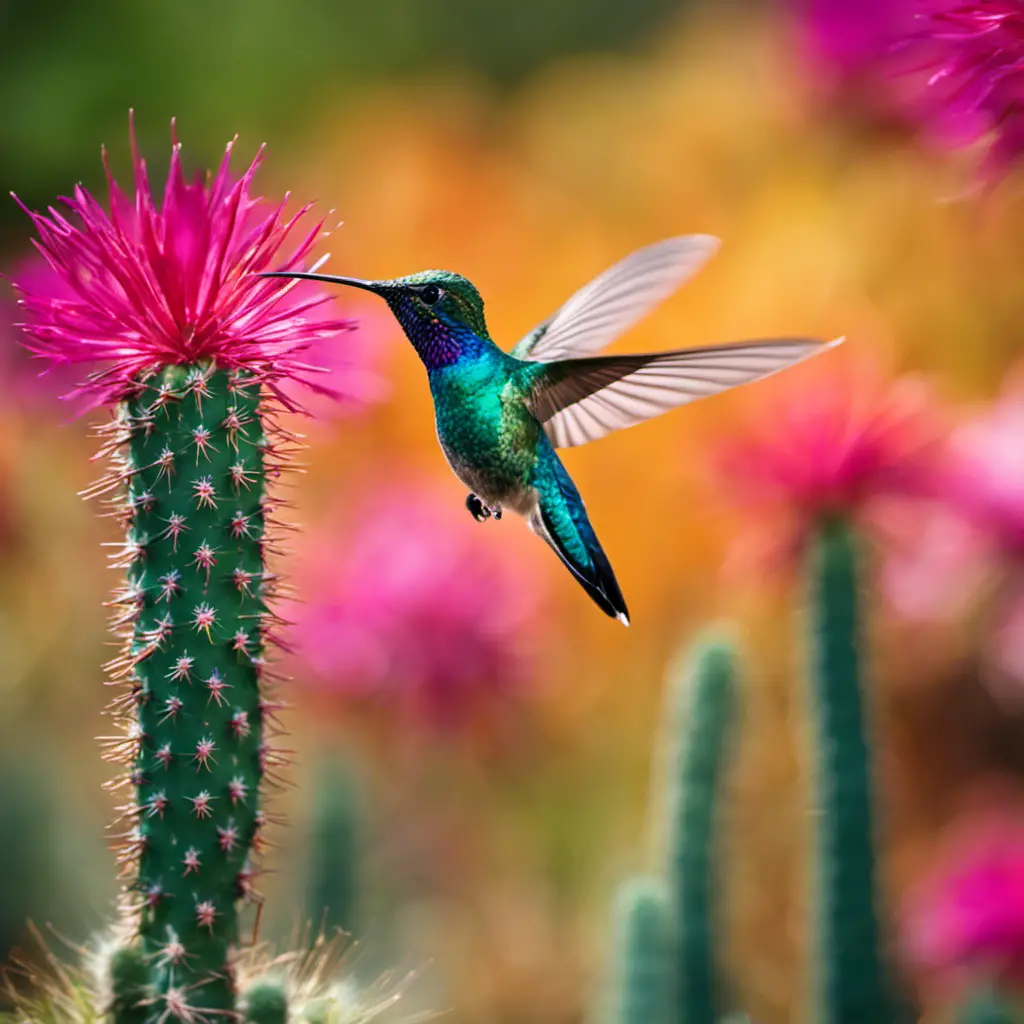Hummingbirds, a diverse and captivating group of avian creatures, are a common sight in the arid landscapes of Arizona. From the vibrant plumage of the Anna’s Hummingbird to the delicate flight patterns of the Black-Chinned Hummingbird, these tiny birds offer a mesmerizing spectacle for nature enthusiasts.
With species such as the Costa’s Hummingbird and the Rufous Hummingbird also making appearances, Arizona provides a unique opportunity to observe and study these remarkable creatures in their natural habitat.
This article delves into the fascinating world of hummingbirds in Arizona, shedding light on their behavior, habitat, and conservation efforts.
Key Takeaways
- There are several species of hummingbirds in Arizona, including Anna’s Hummingbird, Black-Chinned Hummingbird, Costa’s Hummingbird, Broad-Tailed Hummingbird, and Rufous Hummingbird.
- Hummingbirds in Arizona can be found in a variety of habitats, ranging from deserts to forests, and even urban areas.
- They primarily feed on nectar from flowers, but also consume small insects and spiders for protein.
- Some hummingbird species in Arizona are migratory, while others are year-round residents, and they face threats such as habitat loss and climate change.
Anna’s Hummingbird (Calypte anna

The population of Anna’s Hummingbird in Arizona has significantly increased in recent years, indicating a positive trend in their conservation efforts. These delightful birds are native to western North America and are a common sight in Arizona.
They are primarily found in the desert regions, where they prefer habitats with a mix of open space and vegetation, such as gardens, parks, and canyons. Anna’s Hummingbirds build their nests in a variety of locations, including trees, shrubs, and even human-made structures like eaves and clotheslines. They construct their nests using plant materials, spider silk, and feathers, creating a small cup-shaped structure.
When it comes to migration, most Anna’s Hummingbirds in Arizona are non-migratory, staying in their preferred habitats year-round. However, some individuals may undertake short-distance movements to find better food sources or breeding territories.
Understanding the habitat and nesting habits, as well as the migration patterns and behavior, of Anna’s Hummingbirds in Arizona is crucial for their conservation and management.
Black-Chinned Hummingbird

Although smaller in size compared to the Anna’s Hummingbird, the Black-Chinned Hummingbird is another fascinating species that can be found in Arizona. Known for its distinctive black chin, this species is known to have interesting migration patterns and feeding habits.
The Black-Chinned Hummingbird is a migratory species, spending its breeding season in the western United States and Mexico, and then migrating to Central America for the winter. This long-distance migration allows the hummingbirds to follow the blooming flowers and find abundant food sources along their journey.
When it comes to feeding habits, the Black-Chinned Hummingbird primarily feeds on nectar from a variety of flowering plants. They are particularly attracted to red, orange, and pink flowers, as these colors are more visible to them. They also consume small insects and spiders, which provide them with the necessary protein.
To summarize the migration patterns and feeding habits of the Black-Chinned Hummingbird, please refer to the table below:
| Migration Patterns | Feeding Habits |
|---|---|
| Breeds in western US and Mexico | Primarily feeds on nectar |
| Migrates to Central America for winter | Attracted to red, orange, and pink flowers |
| Follows blooming flowers for food | Consumes small insects and spiders for protein |
Costa’s Hummingbird

Costa’s Hummingbird, a native species of the Sonoran Desert, displays beautiful iridescent plumage and demonstrates unique territorial behavior. This small bird, measuring around 3.5 inches in length, is known for its vibrant green back and crown, contrasting with its white underparts. The male Costa’s Hummingbird is particularly striking, with its iridescent purple throat patch, or gorget, which reflects light in various angles.
One interesting aspect of Costa’s Hummingbird is its migration patterns. While some individuals are year-round residents in the desert, others undertake seasonal migrations. These migrations are primarily influenced by the availability of food resources and changes in weather patterns.
During the breeding season, which typically occurs from February to May, male Costa’s Hummingbirds establish territories and perform elaborate courtship displays to attract females. These displays involve aerial acrobatics, rapid wingbeats, and vocalizations.
Understanding the migration patterns and mating behavior of Costa’s Hummingbird is crucial for conservation efforts and maintaining healthy populations of these stunning birds in the Sonoran Desert.
Broad-Tailed Hummingbird
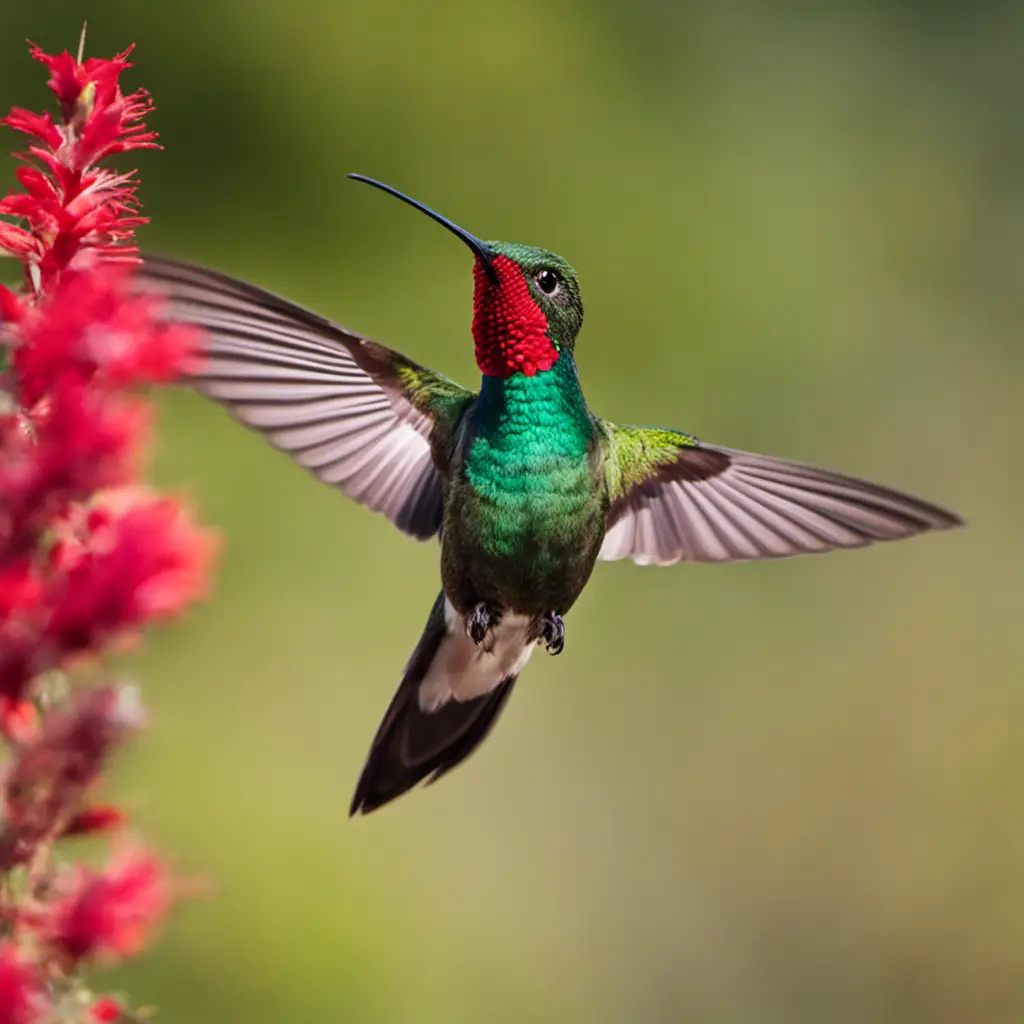
Several species of hummingbirds, including the Broad-Tailed Hummingbird, are known for their ability to hover in mid-air.
The Broad-Tailed Hummingbird (Selasphorus platycercus) is a small bird found in the western parts of North America, including Arizona. These hummingbirds are known for their striking iridescent green plumage, with the males having a distinctive metallic red throat patch or gorget.
Their migration patterns, like many other hummingbirds, are quite remarkable. In the spring, they travel from their wintering grounds in Mexico and Central America to breed in the mountainous regions of Arizona. The males perform an elaborate courtship display to attract females, involving aerial acrobatics and the production of a distinctive buzzing sound with their wings.
Understanding these behaviors is crucial for conservation efforts and ensuring the long-term survival of these beautiful creatures.
Rufous Hummingbird
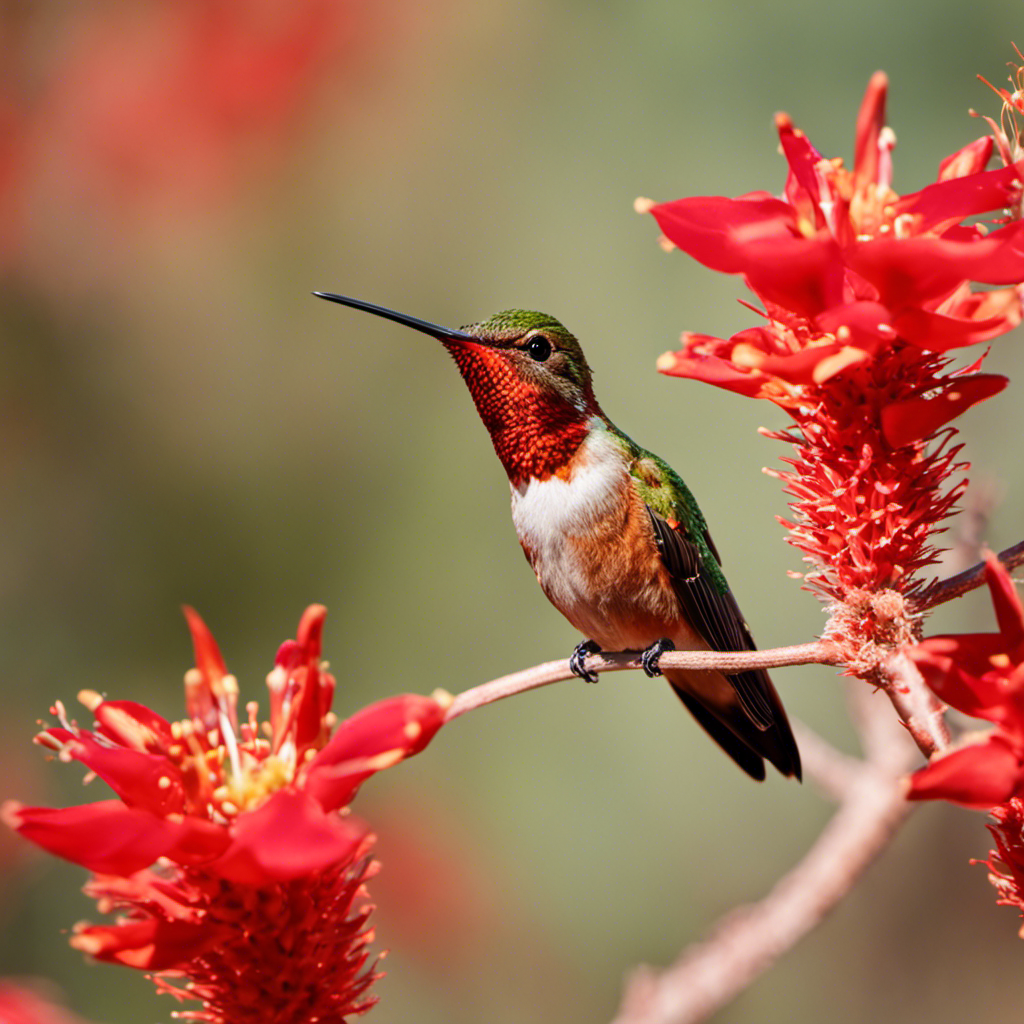
Observing the Rufous Hummingbird in its natural habitat, researchers have noted its remarkable ability to fly long distances during its annual migration. These tiny birds travel from their breeding grounds in the Pacific Northwest to their wintering grounds in Central America, covering a distance of up to 3,000 miles. The Rufous Hummingbird’s migration patterns are fascinating to study, as they exhibit a highly efficient navigation system that allows them to find their way back to the same breeding grounds year after year.
When it comes to feeding habits, the Rufous Hummingbird is known for its aggressive nature. They are highly territorial and fiercely defend their nectar-rich feeding areas from other hummingbirds and even larger birds. Their diet primarily consists of flower nectar, but they also consume insects and spiders for protein. To extract nectar from flowers, these hummingbirds use their long, specialized beaks and extendable tongues, which allow them to reach deep into the flower’s corolla.
Calliope Hummingbird

The researchers have been conducting experiments to gather data on the foraging behavior of the Calliope Hummingbird in order to better understand its preferred nectar sources.
The Calliope Hummingbird (Selasphorus calliope) is a small species of hummingbird found in North America. Known for its vibrant plumage and distinctive calliope-like song, this species has captured the interest of scientists studying its migration patterns and nesting habits.
During the breeding season, Calliope Hummingbirds can be found in mountainous regions of western North America, including Arizona. They are known to migrate long distances, often traveling from their wintering grounds in Mexico to their breeding sites in the north. Understanding their migration patterns is crucial for conservation efforts.
Additionally, researchers are studying the nesting habits of Calliope Hummingbirds to gain insights into their reproductive success and population dynamics. By unraveling the mysteries of this fascinating species, scientists hope to contribute to its conservation and management.
Lucifer Hummingbird

The Lucifer Hummingbird, known for its iridescent green feathers and long, curved bill, is often mistaken for the Calliope Hummingbird due to their similar size and habitat preferences. However, there are distinct differences between these two species.
The Lucifer Hummingbird is primarily found in the mountainous regions of Arizona, New Mexico, and western Texas, whereas the Calliope Hummingbird prefers more open habitats such as meadows and sagebrush.
The Lucifer Hummingbird has a unique migration pattern, with individuals traveling from their breeding grounds in the United States to their wintering grounds in Mexico. These hummingbirds rely on nectar from various flowering plants, including penstemon and agave, which are abundant in their preferred habitats.
Understanding the habitat preferences and migration patterns of the Lucifer Hummingbird is crucial for conservation efforts and ensuring their continued survival in the wild.
Violet-Crowned Hummingbird
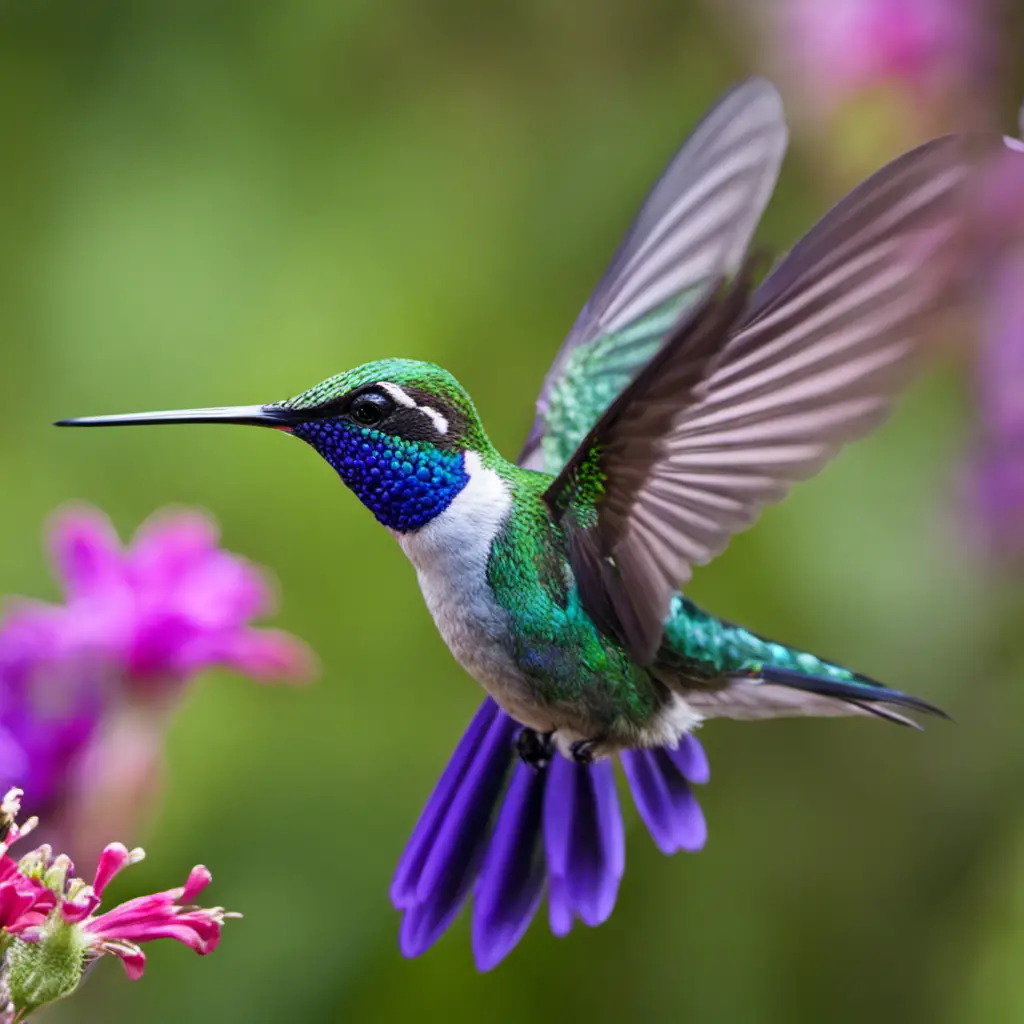
One of the most striking features of the Violet-Crowned Hummingbird is its vibrant purple crown, which sets it apart from other hummingbird species.
This small bird, scientifically known as Amazilia violiceps, is native to the southwestern United States and parts of Mexico. Conservation efforts have been made to protect this species, as it faces threats from habitat loss and climate change.
The Violet-Crowned Hummingbird is known for its unique migration patterns. It is a long-distance migrant, traveling from its breeding grounds in the mountains of Mexico to its wintering grounds in Arizona. These birds are able to cover impressive distances during their migration, often flying hundreds of miles nonstop.
Understanding their migration patterns is essential for implementing effective conservation strategies to ensure the survival of this beautiful and charismatic species.
Berylline Hummingbird

The Berylline Hummingbird is a species of hummingbird found in the southwestern United States and northern Mexico, known for its iridescent green coloration and unique feeding habits. These small birds have a distinctive long and slightly curved bill, which enables them to reach nectar deep within flowers.
They primarily inhabit forested areas, preferring subtropical and pine-oak forests. Berylline hummingbirds are known to migrate between their breeding grounds in Mexico and their wintering grounds in the southwestern United States, with some individuals even venturing as far north as Arizona. During migration, they exhibit remarkable endurance, flying long distances to reach their destinations.
They are also highly territorial, defending their feeding territories vigorously. Observations have shown that berylline hummingbirds are particularly attracted to red or orange tubular flowers, which provide them with a rich source of nectar.
Blue-Throated Mountain Gem
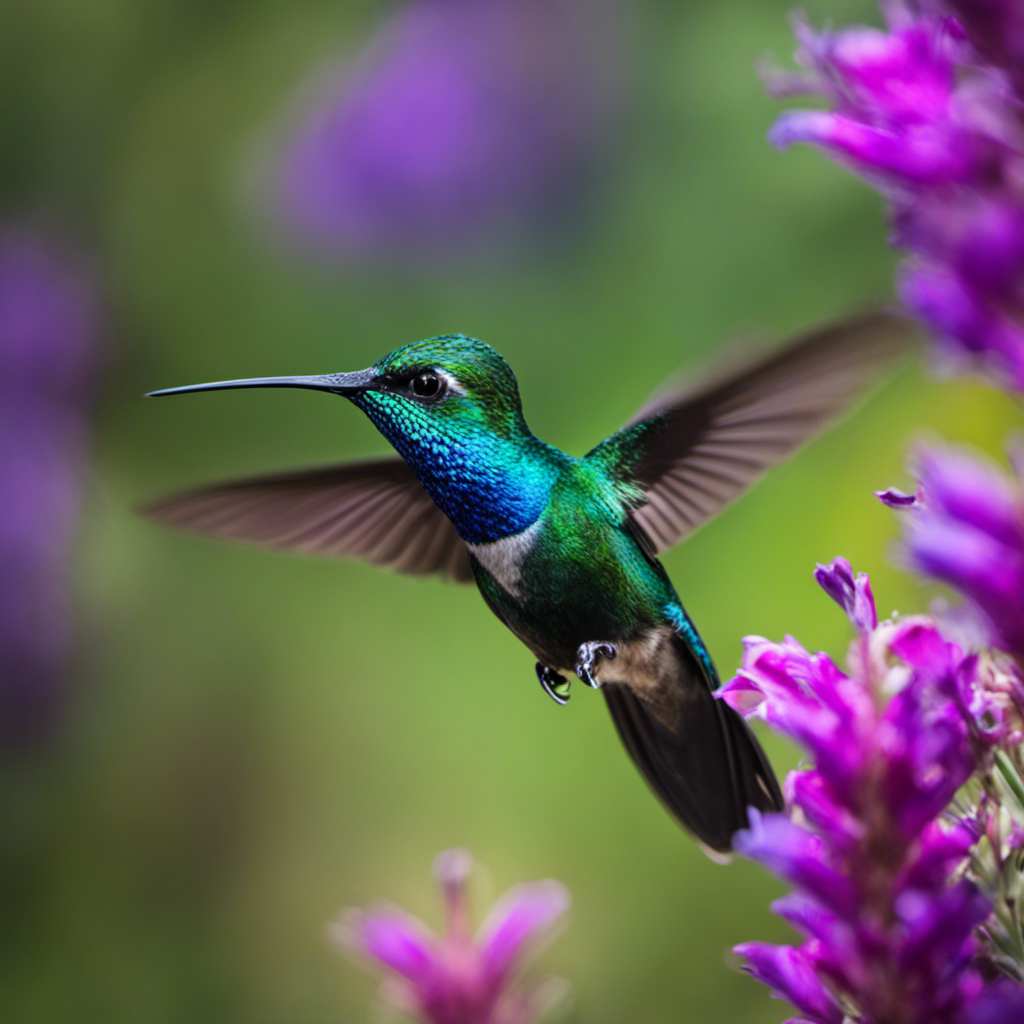
Blue-Throated Mountain Gems are known for their vibrant blue throats and are frequently observed hovering near crimson flowers to feed on nectar. These magnificent hummingbirds can be found in the mountainous regions of Arizona, where they have adapted to their unique habitat and feeding habits. They prefer coniferous forests and can often be seen darting through the trees in search of food. Blue-Throated Mountain Gems primarily feed on nectar from flowers, using their long, slender bills to extract the sweet liquid. They also consume small insects and spiders for additional protein. To engage the audience further, here is a table highlighting some interesting facts about Blue-Throated Mountain Gems:
| Fact | Description |
|---|---|
| Scientific Name | Lampornis clemenciae |
| Average Size | 10 cm (4 inches) |
| Habitat | Coniferous forests in mountainous regions of Arizona |
| Conservation Status | Near Threatened |
Conservation efforts are crucial to ensure the survival of these beautiful birds. Preservation of their habitat, control of invasive species, and raising awareness about their importance in pollination are some key initiatives undertaken for their conservation. By understanding and appreciating the blue-throated mountain gem, we can contribute to their protection and conservation.
Broad-Billed Hummingbird

With its vibrant plumage and curved bill, the Broad-Billed Hummingbird is a stunning species commonly found in the southwestern regions of the United States, including Arizona. This remarkable bird has unique feeding habits and breeding patterns that set it apart from other hummingbirds.
Here are some interesting facts about the Broad-Billed Hummingbird:
Feeding Habits:
Broad-Billed Hummingbirds primarily feed on nectar from flowers, using their long, extendable tongues to reach deep into the flower’s corolla.
They are known to be highly territorial and will fiercely defend their feeding territories, often chasing away other hummingbirds.
In addition to nectar, these birds also consume small insects and spiders, which provide them with essential protein and nutrients.
Breeding Patterns:
Broad-Billed Hummingbirds are known for their elaborate courtship displays, which involve impressive aerial acrobatics and vibrant displays of their colorful plumage.
Females build small cup-shaped nests using plant materials and spider silk, typically high in trees or shrubs.
Once the female lays her eggs, she takes sole responsibility for incubating them and raising the chicks, while the male defends the territory.
Frequently Asked Questions
What Is the Average Lifespan of a Hummingbird?
The average lifespan of a hummingbird varies depending on species, diet, and environmental factors. These small birds are known for their rapid wing beats, vibrant colors, and unique nesting habits, making them fascinating subjects for scientific study and observation.
How Do Hummingbirds Build Their Nests?
Hummingbird nest construction involves gathering various materials such as twigs, leaves, moss, and spider silk. The birds meticulously weave these items together to create a small cup-shaped nest. This intricate process showcases the ingenuity and resourcefulness of these remarkable avian creatures.
What Is the Migratory Pattern of Hummingbirds in Arizona?
Hummingbird migration patterns in Arizona vary depending on the species. Some species, like the Rufous hummingbird, migrate through Arizona during their long-distance journeys, while others, like the Anna’s hummingbird, are resident birds and do not migrate.
How Do Hummingbirds Communicate With Each Other?
Hummingbirds communicate with each other through a variety of vocalizations and courtship behaviors. These unique vocalizations, such as chirping and trilling, serve as a means for attracting mates and establishing territory. Their courtship behaviors involve elaborate displays of flight and physical movements.
What Is the Role of Hummingbirds in Pollination?
Hummingbirds play a crucial role in plant reproduction as pollinators. Their specialized beaks and long tongues allow them to access nectar deep within flowers, transferring pollen as they feed. This symbiotic relationship is vital for the survival of many hummingbird-pollinated flowers.
Conclusion
In conclusion, Arizona is home to a diverse range of hummingbird species. This includes the Anna’s Hummingbird, Black-Chinned Hummingbird, Costa’s Hummingbird, Broad-Tailed Hummingbird, Rufous Hummingbird, Violet-Crowned Hummingbird, Berylline Hummingbird, Blue-Throated Mountain Gem, and Broad-Billed Hummingbird.
These exquisite creatures display intricate behaviors and adaptations that allow them to thrive in the arid and varied landscapes of Arizona. Studying and appreciating the unique hummingbird species in this region contributes to our understanding of their ecological significance and the importance of preserving their habitats.

An avid ornithologist, zoologist and biologist with an unwavering passion for birds and wild animals.
Dr. Wilson’s journey in ornithology began in childhood and led him to obtain a Ph.D. in Ornithology from the prestigious Avian Research Institute. He has worked closely with renowned experts in the field and conducted extensive research and field studies globally.

